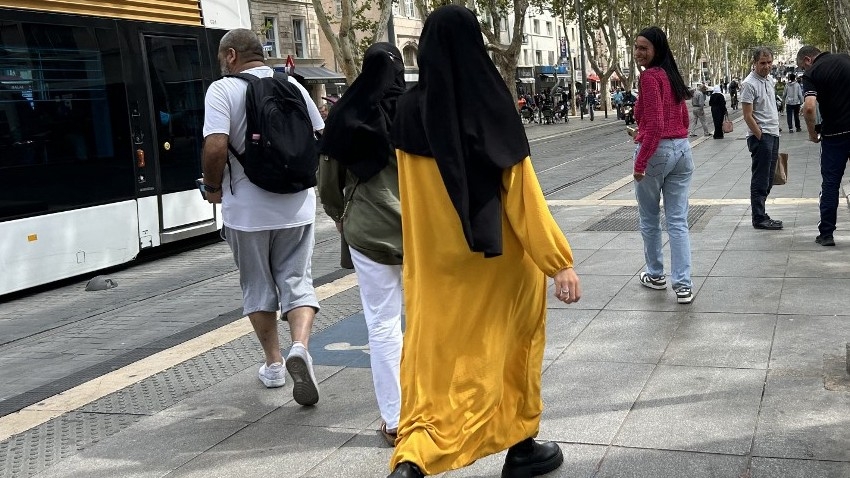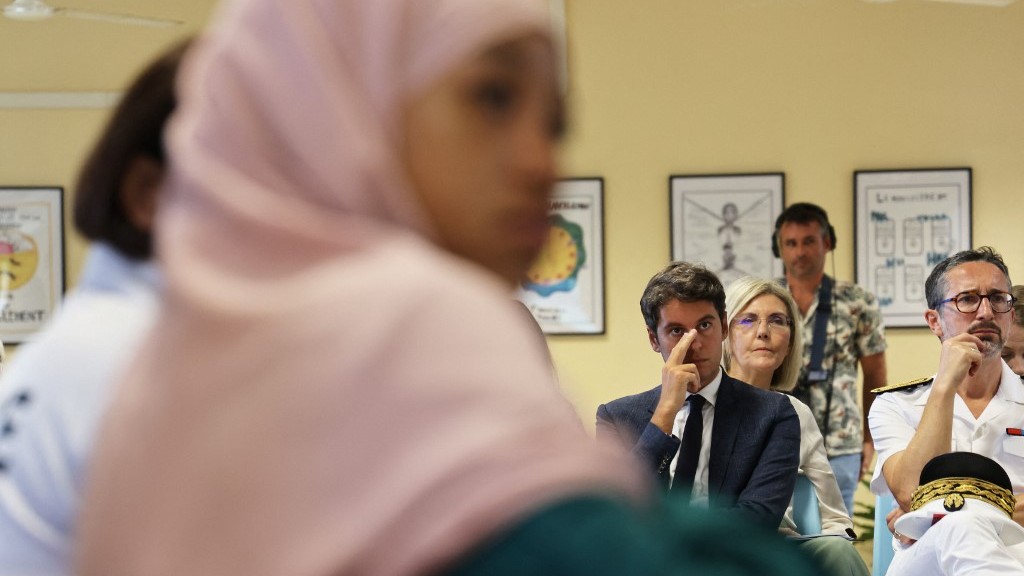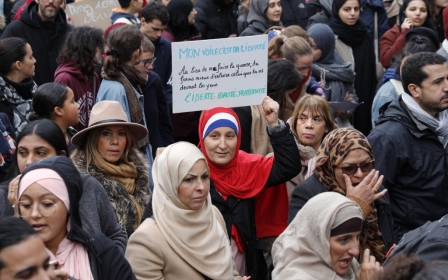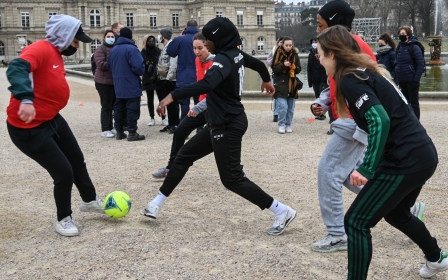France abaya ban: Muslim girls gear up for return to school without long dresses

At the Vigneux-sur-Seine media library in Essonne, a southern suburb of Paris, the atmosphere is deceptively studious on this afternoon of 28 August.
Seated at a table, Hassina and Besma, both 15 years old, chat while flipping through interior decoration magazines. They are still making the most of the last days of their vacation to relax before heading back to school.
"I hope everything goes well," Hassina says anxiously while speaking to Middle East Eye. The young girl, dressed in an abaya, a loose traditional dress covering the arms and legs, expresses her fear that her clothing might cause her problems.
"I've already had problems with the principal of my middle school last year. This time, I'm afraid I'll have to part with the abaya for good to enter high school," she says.
On the evening news of TF1 the previous day, Education Minister Gabriel Attal was uncompromising: wearing the abaya will no longer be allowed in educational institutions as it goes against the principles of secularism, according to Attal.
Stay informed with MEE's newsletters
Sign up to get the latest alerts, insights and analysis, starting with Turkey Unpacked
"Secularism is precisely about allowing individuals to dress as they want. It's respecting everyone's freedom," Besma says. More determined than her friend, she doesn't plan on backing down, and says she's ready to defend her choice of clothing.
For her visit to the library, the new high school student has chosen to wear a rosewood-coloured abaya, paired with a trendy pair of sneakers. The handbag sitting on the table also reveals her keen taste for fashion and novelty.
"I discovered abayas during my summer holidays in Algeria. My cousins wear them for all sorts of occasions, like weddings, going to the market, or simply for a stroll. It's a comfortable and flattering garment," Besma tells MEE.
Hassina shares Besma's sentiment, saying that the clothing also allows her to conceal her weight and move without self-consciousness. "It has nothing to do with religion. The proof is, I don't wear a headscarf," she says.
Last year, when the school administration had asked her to remove her abaya following a directive from former education minister, Pap Ndiaye, the schoolgirl had offered the same explanation, without success. In her presence, the principal had described it as a "folkloric garment" that has no place in an educational institution.
"It's a display of contempt that I can't stand," says Imane, a former classmate of Hassina who had witnessed the exchange. "Just for that reason, I want to wear the abaya everywhere and all the time."
Imane, like her friend, lives in the working-class neighbourhood of Croix-Blanche, a short distance from the media library.
In this housing estate with more than 3,000 units, where MEE met her, the riots that rocked France at the end of June have left their mark. Shops were looted, and the local community centre was vandalised following the death of Nahel, a 17-year-old youth killed by a police officer in Nanterre, north of Paris, after refusing to comply with a police demand.
Naziha, one of the facilitators at the social centre, says: "The youth revolted due to issues of injustice, racism, and unemployment. There's nothing here except the drug trade, which is increasing the number of delinquents every day."
Inside this welcoming place with colourful walls, where Imane seeks refuge during the summer to escape boredom, mothers also come with their children for recreational activities or chitchat.
Some wear headscarves, others wear abayas, pants or traditional Sub-Saharan African clothing. "Does the form, length, or colour really matter?" Fatima, who lives in the neighbourhood, asks.
More seriously, she regrets that the abaya issue intentionally targets Muslims. "It's been a while since we were in the spotlight. They had to reignite the controversy to overshadow the real problems," she says.
'Stigmatised over a piece of fabric'
One of Fatima's neighbours, Rokaya, lists the neighbourhood's difficulties, including the increasing cost of living.
"As if banning the abaya could solve everything. Here, the school mainly produces young people adrift, wandering around the estate all day," she says, pointing towards a group of noisy teenagers obstructing the entrance of a building in the distance.
Among the group is her 15-year-old son, whose schooling has been difficult. "His two sisters are doing much better. They persist despite the obstacles and are determined to succeed at all costs," Rokaya says.
'I don't want to miss hours of classes or get expelled because of an abaya, especially in a crucial year for me. It's unjust, but that's how it is'
- Farah, Muslim student
To assist them, she doesn't hesitate to ask them to make certain compromises, such as no longer wearing the abaya to go to middle school. Last year, the two young girls had already swapped their long dresses for loose pants and sweatshirts.
"I don't want this clothing issue to negatively impact their education, for them to be stigmatised over a piece of fabric, whether it's religious or not," says Rokaya.
The situation of her daughters reminds her of her own young days, 34 years ago, when she herself had to give up the idea of wearing the veil.
It was in 1989. Leila, Fatima and Samira, three middle school students who had refused to remove their headscarves in class, had been expelled from their school in Creil, in the Oise region north of Paris.
A debate on secularism had followed, resolved a few weeks later by the Council of State, which determined that wearing the Islamic veil was not incompatible with the principle of secularism.
"My father, may he rest in peace, didn't give me a choice. For him, an illiterate Moroccan worker, school was more important than anything else," says Rokaya.
Since then, this homemaker has worn the veil, and she now sees her home as the only space of freedom that remains for her. "Outside, I know that my headscarf isn't always well received and that my religion is met with suspicion," she says.
Imane, who covers her head outside of school, also doesn't accept that the headscarf and abaya are treated as republican threats. "Anything is an excuse to target Muslims," she says.
Imane also wonders how school administrators will distinguish between a long dress and an abaya. "Perhaps by the colour of the skin and the names of those who wear them," she suggests.
At the social centre, which is preparing to close, most of the women have already left. Farah, one of Fatima's daughters, a high-school senior, accepts her fate. "I don't want to miss hours of classes or get expelled because of an abaya, especially in a crucial year for me. It's unjust, but that's how it is," she says.
Her mother, nodding in agreement yet powerless, still regrets that young girls like hers are already experiencing discrimination while their heads are still full of dreams.
*This article was originally published in French.
Middle East Eye delivers independent and unrivalled coverage and analysis of the Middle East, North Africa and beyond. To learn more about republishing this content and the associated fees, please fill out this form. More about MEE can be found here.






